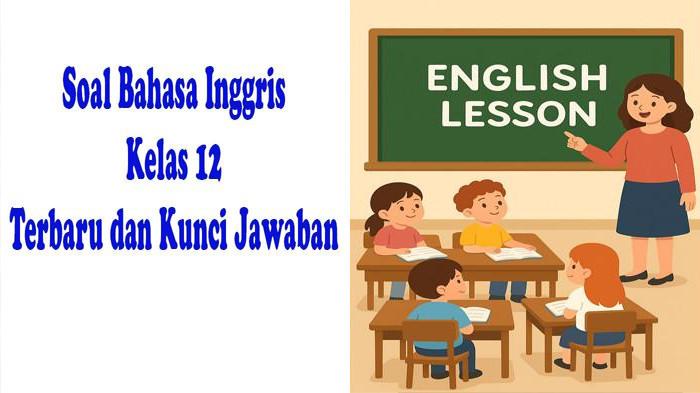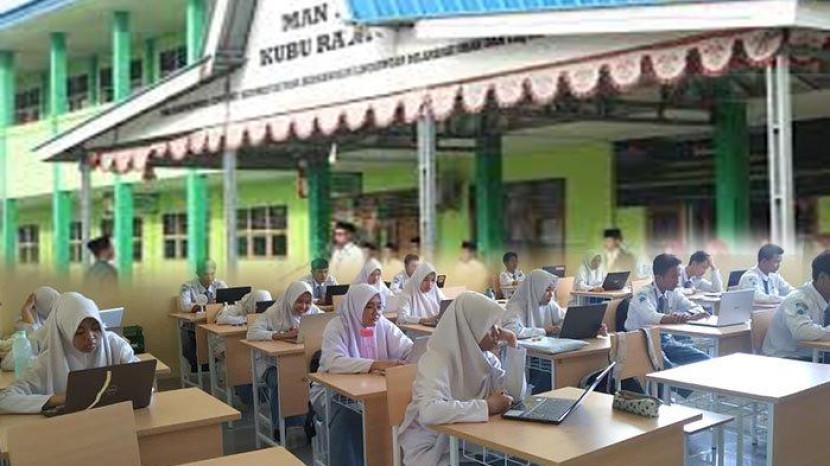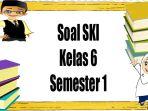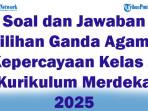TKA Bahasa Indonesia
20 Soal dan Jawaban TKA Bahasa Inggris SMA, Tes Evaluasi Jenjang Pendidikan
Disusun berdasarkan standar kurikulum terbaru untuk menguatkan pemahaman terhadap evaluasi menyeluruh
TRIBUNPONTIANAK.CO.ID - Inilah soal Bahasa Inggris SMA untuk menghadapi Tes Kompetensi Akademik (TKA) tahun ini.
Pembelajaran ini bisa menjadi panduan bagi orang tua, siswa dan guru.
Soal - soal ini cocok dijadikan pembelajaran untuk menghadapi latihan evaluasi TKA.
Disusun berdasarkan standar kurikulum terbaru untuk menguatkan pemahaman terhadap evaluasi menyeluruh untuk pelajaran Bahasa Inggris.
Terdiri dari soal pilihan ganda yang dapat dijadikan sebagai pengalaman.
Baca juga: JAWABAN PAI Kelas 12 Bab 3 Soal Pilihan dan Essay Buku Paket Hadapi Ulangan UTS/PTS Semester 1
Soal TKA Bahasa Inggris SMA
1. In a neurology ward, a patient presents with sudden weakness on the left side of the body, slurred speech, and facial drooping. The attending physician suspects an ischemic stroke and orders an urgent CT scan to rule out hemorrhage. Given the time-sensitive nature of this condition, early intervention with thrombolytic therapy can drastically improve patient outcomes. Which artery is most likely occluded in this clinical scenario?
A. Middle cerebral artery
B. Anterior cerebral artery
C. Basilar artery
D. Posterior communicating artery
E. Vertebral artery
Answer: A
2. A 58-year-old male with a history of uncontrolled hypertension suddenly collapses and becomes unresponsive. On examination, he has unequal pupils and loss of consciousness. A CT scan reveals a massive intracerebral hemorrhage. Considering the risk factors, location, and pathophysiology, which brain structure is most commonly affected in hypertensive hemorrhages?
A. Cerebellum
B. Basal ganglia
C. Medulla oblongata
D. Thalamus
E. Occipital lobe
Answer: B
3. A 30-year-old female presents with recurrent episodes of unilateral throbbing headache associated with nausea, vomiting, and photophobia. The attacks last for several hours and are often preceded by visual disturbances such as flashing lights. Based on the clinical features, which neurotransmitter imbalance plays a central role in the pathophysiology of this disorder?
A. Dopamine
B. Acetylcholine
C. Serotonin
D. GABA
E. Glutamate
Answer: C
4. A patient is diagnosed with Parkinson’s disease after showing symptoms of resting tremor, bradykinesia, and rigidity. The disease is associated with the progressive degeneration of dopaminergic neurons. Which specific brain region is primarily affected in Parkinson’s disease?
A. Substantia nigra pars compacta
B. Hippocampus
C. Amygdala
D. Subthalamic nucleus
E. Caudate nucleus
Answer: A
5. A 40-year-old man presents with sudden, severe, “thunderclap” headache described as the worst headache of his life. He has neck stiffness but no focal neurological deficits. A CT scan shows no abnormalities, but suspicion for subarachnoid hemorrhage remains high. What is the next best diagnostic step?
A. MRI of the brain
B. Lumbar puncture
C. Carotid Doppler ultrasound
D. Electroencephalogram
E. Cerebral angiography
Answer: B
6. A 65-year-old patient has difficulty understanding spoken language but can speak fluently, although the words often lack meaning. This condition is associated with damage to a specific cortical area involved in language comprehension. Which area is most likely affected?
A. Broca’s area
B. Wernicke’s area
C. Angular gyrus
D. Prefrontal cortex
E. Supplementary motor area
Answer: B
7. During a neurological examination, a patient exhibits spastic paralysis, hyperreflexia, and a positive Babinski sign on the right side of the body. These findings indicate an upper motor neuron lesion. Which of the following locations is most likely involved?
A. Anterior horn of spinal cord
B. Cerebral cortex
C. Neuromuscular junction
D. Peripheral nerves
E. Muscle fibers
Answer: B
8. A 22-year-old man develops sudden weakness in both legs after a viral infection. Neurological examination shows absent deep tendon reflexes, flaccid paralysis, and preserved sensation. Cerebrospinal fluid analysis reveals elevated protein with normal cell count (albuminocytologic dissociation). What is the most likely diagnosis?
A. Multiple sclerosis
B. Myasthenia gravis
C. Guillain-Barré syndrome
D. Amyotrophic lateral sclerosis
E. Poliomyelitis
Answer: C
9. A 50-year-old man presents with progressive weakness and muscle wasting in both upper and lower limbs, accompanied by fasciculations. Sensory functions remain intact. The disease eventually affects respiratory muscles, leading to death. Which motor neurons are affected in this condition?
A. Only upper motor neurons
B. Only lower motor neurons
C. Both upper and lower motor neurons
D. Cerebellar neurons
E. Sensory neurons
Answer: C
10. A 36-year-old woman presents with double vision that worsens with fatigue and improves with rest. Physical examination reveals ptosis and weakness in extraocular muscles. She is diagnosed with myasthenia gravis. Which receptor is targeted by autoantibodies in this disorder?
A. Dopamine receptor
B. Nicotinic acetylcholine receptor
C. Muscarinic acetylcholine receptor
D. GABA receptor
E. Serotonin receptor
Answer: A
11. Many environmental scientists argue that the effects of climate change are not limited to rising global temperatures, but also include extreme weather events such as hurricanes, floods, and droughts. A recent study has shown that developing countries are the most vulnerable, as they often lack the infrastructure and resources to cope with such disasters. The text also highlights that although international agreements have been made to reduce carbon emissions, many industrial nations continue to prioritize economic growth over environmental sustainability. Based on the information in the passage, what is the main idea being emphasized?
A.International agreements have no impact on climate change
B. Climate change only increases global temperature
C. Developing countries suffer the most from climate change
D. Economic growth and environmental sustainability often conflict
E. Hurricanes and floods are unrelated to climate change
Answer: D
12. In the past two decades, communication has transformed drastically. Social media has enabled people to connect instantly, share knowledge, and build communities across borders. However, it also creates problems such as misinformation, cyberbullying, and decreased face-to-face interaction. The lecturer in the passage suggests that students should evaluate both the advantages and disadvantages before forming a conclusion. What should students do according to the lecturer?
A.Use it as frequently as possible to share information
B. Avoid it completely to prevent misinformation
C. Focus only on the benefits and ignore the risks
D. Analyze both positive and negative impacts before deciding
E. Consider it as the best tool for education without limitations
Answer: D
13. Despite the importance of renewable energy, many governments don’t invest enough funds, which leads to slow progress in combating climate change. The sentence contains a grammatical inaccuracy that may confuse readers if not corrected. You are asked to carefully analyze the subject-verb agreement and auxiliary usage in the sentence. Which of the following options makes the sentence grammatically correct?
A. Many governments doesn’t invest enough funds
B. Many governments don’t invests enough funds
C. Many governments doesn’t invests enough funds
D. Many governments don’t invest enough funds
E. Many governments didn’t invest enough funds
Answer: D
14. Last week, Maria said, “I am preparing my research presentation for the international conference.” Her teacher later reported this to the principal. You are asked to transform Maria’s direct speech into reported speech. Remember that tense changes are required when reporting past events, and pronouns should also be adjusted. Which of the following sentences is correct?
A.Maria said she prepares her research presentation
B. Maria said she was preparing her research presentation
C. Maria said she had prepared her research presentation
D. Maria said she is preparing her research presentation
E. Maria said she has prepared her research presentation
Answer: B
15. By the time the new library was officially opened, students had already borrowed digital resources provided by the school’s online system. This initiative showed that learners adapted quickly to technological changes in education. The text suggests that traditional facilities, though important, may not always be the primary source of knowledge in the modern era. What is the main emphasis of this passage?
A.Students no longer need a library for learning
B. Online resources are increasingly utilized before physical facilities
C. Libraries remain the only reliable source of knowledge
D. Digital resources are less effective than printed books
E. Students are reluctant to adapt to technology
Answer: B
16. In a clinical case, a 52-year-old man presents with persistent hypertension that does not improve despite lifestyle modifications and regular exercise. He reports a family history of cardiovascular disease and his BMI indicates overweight status. His blood pressure consistently measures above 150/95 mmHg over three separate visits. Considering the current guidelines, what is the most appropriate initial pharmacological management for this patient?
A. Lifestyle modifications only
B. Thiazide diuretics
C. Beta-blockers as first-line therapy
D. Calcium channel blockers
E. High-dose statins immediately
Answer: B
17. A researcher is studying the effects of nutrition on childhood obesity in a primary school population. He collects data on BMI, dietary habits, and physical activity levels. The study design involves following the same children for five years to see how their habits influence obesity risk. What type of research design is most appropriate to classify this study?
A. Cross-sectional study
B. Case-control study
C. Randomized controlled trial
D. Cohort study
E. Meta-analysis
Answer: D
18. A 68-year-old woman comes with complaints of frequent urination, excessive thirst, and unexplained weight loss over the last two months. Laboratory results show elevated fasting blood glucose at 180 mg/dL. The physician suspects type 2 diabetes mellitus. Which diagnostic test provides the strongest confirmation for the diagnosis?
A. Random blood glucose measurement
B. Oral glucose tolerance test (OGTT)
C. HbA1c test ≥ 6.5 persen
D. Fasting blood glucose on a single occasion
E. Urinalysis for glucose presence
Answer: C
19. A public health officer is evaluating the effectiveness of a vaccination program against measles in a rural community. He compares the incidence of measles cases before and after the vaccination campaign, using official health records. Which epidemiological measure is most suitable to determine the program’s success?
A. Case fatality rate
B. Prevalence rate
C. Incidence rate
D. Mortality rate
E. Relative risk
Answer: C
20. During a health policy debate, policymakers are considering mandatory labeling of packaged foods to include calorie counts and sugar content. The intention is to encourage healthier consumer choices and reduce obesity prevalence. Which principle of public health ethics is most relevant to justify this intervention?
A. Beneficence
B. Non-maleficence
C. Justice
D. Autonomy
E. Utility
Answer: A
- Baca Berita Terbaru Lainnya di GOOGLE NEWS
- Dapatkan Berita Viral Via Saluran WhatsApp
!!!Membaca Bagi Pikiran Seperti Olahraga Bagi Tubuh!!!

















Isi komentar sepenuhnya adalah tanggung jawab pengguna dan diatur dalam UU ITE.